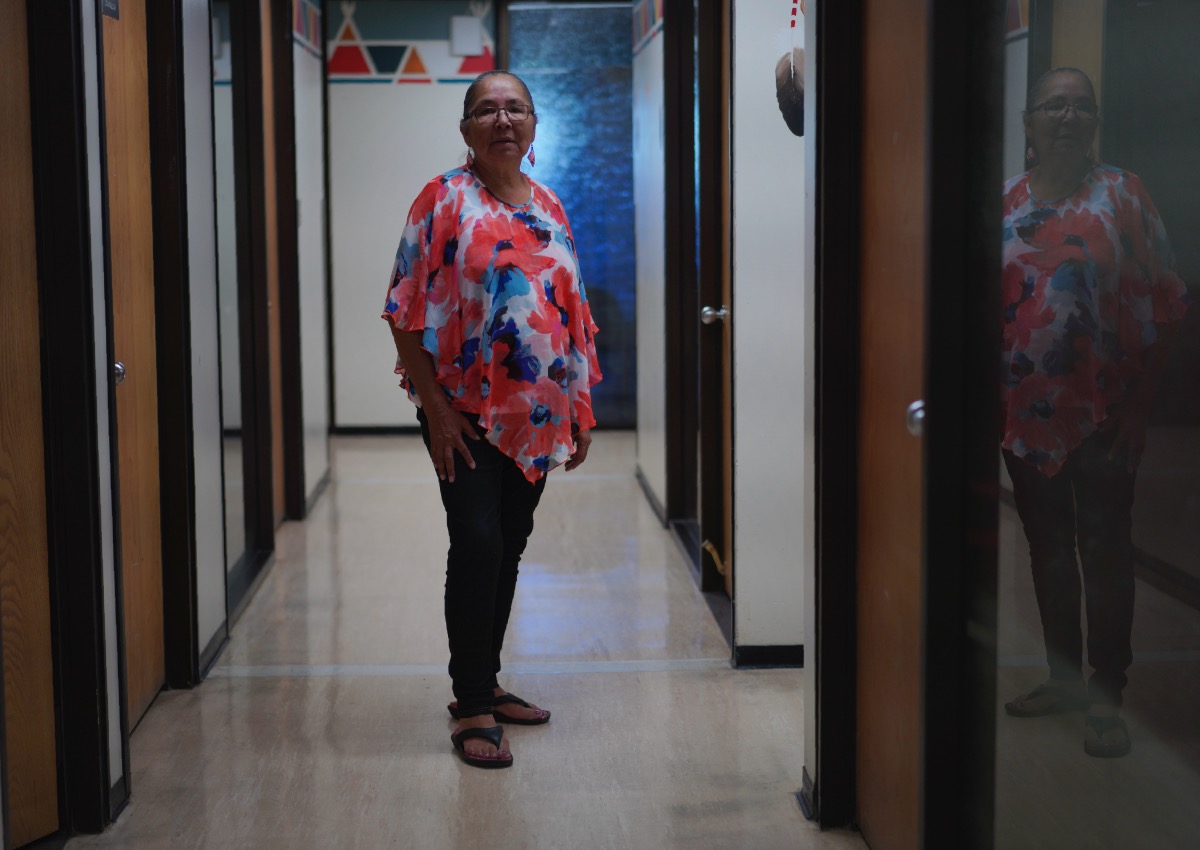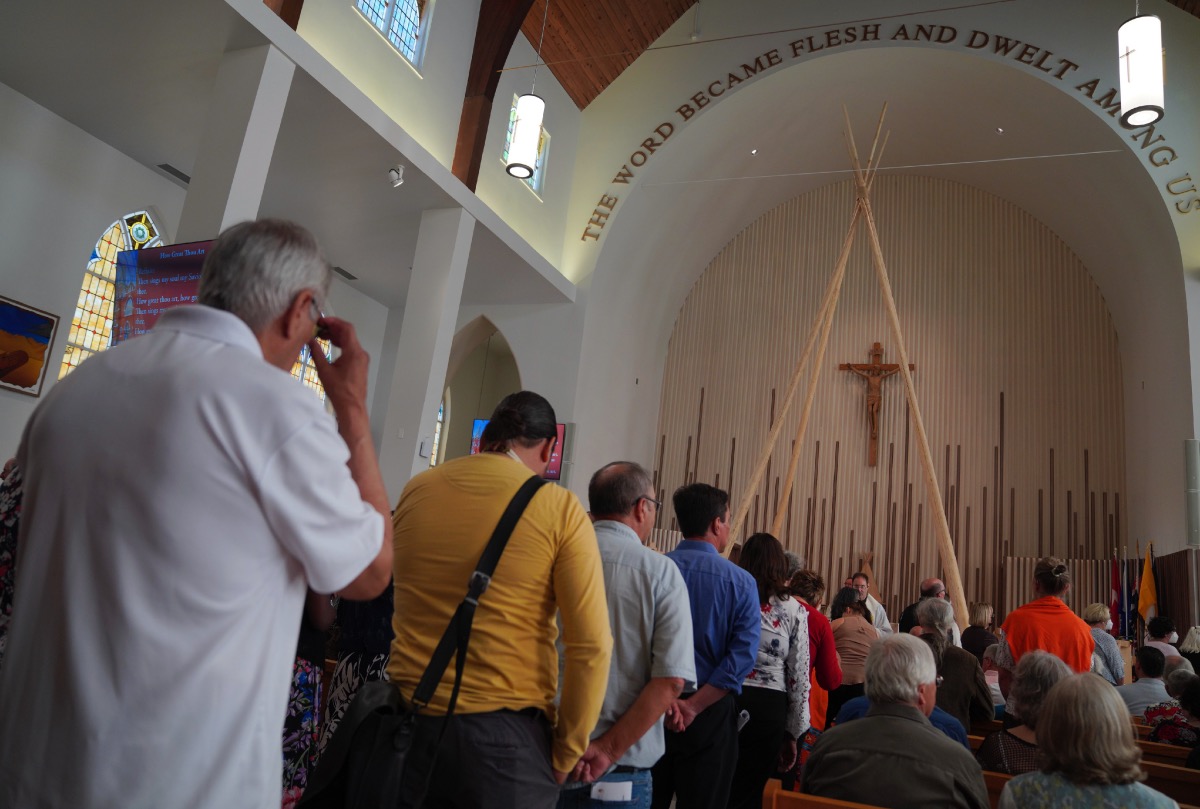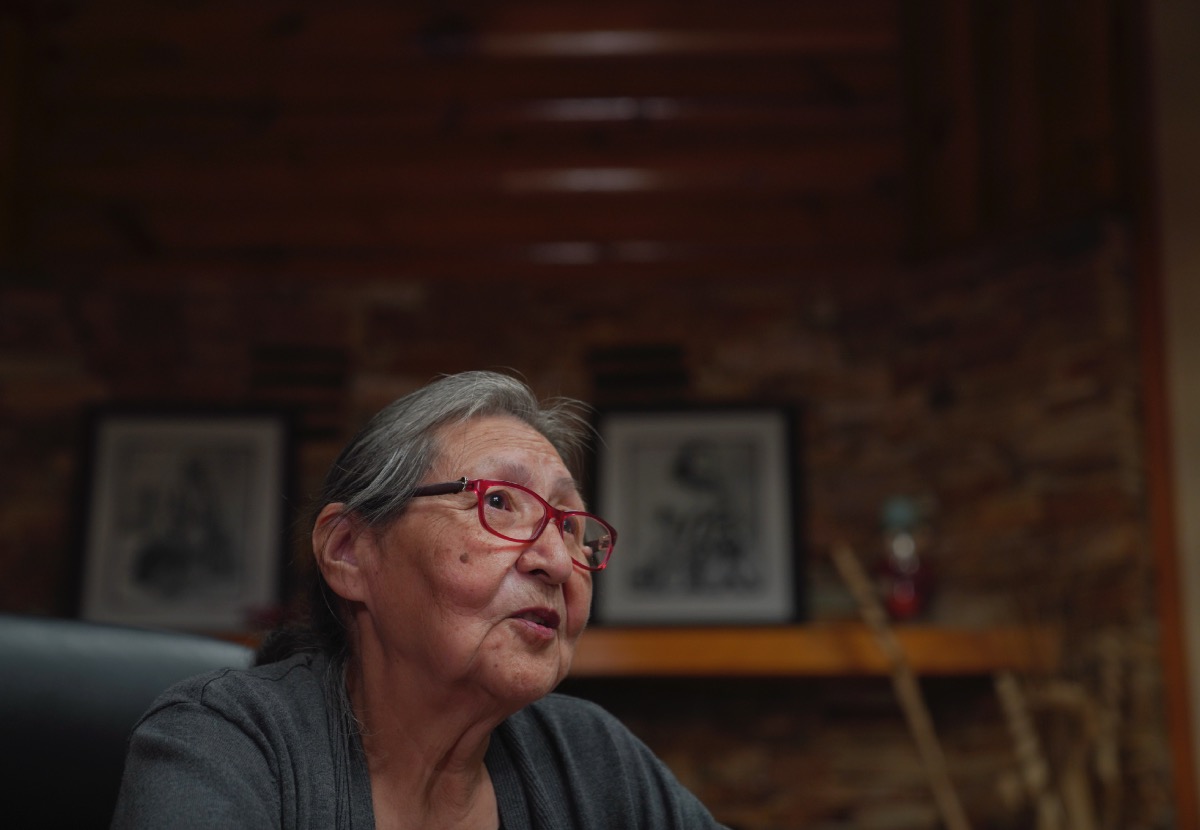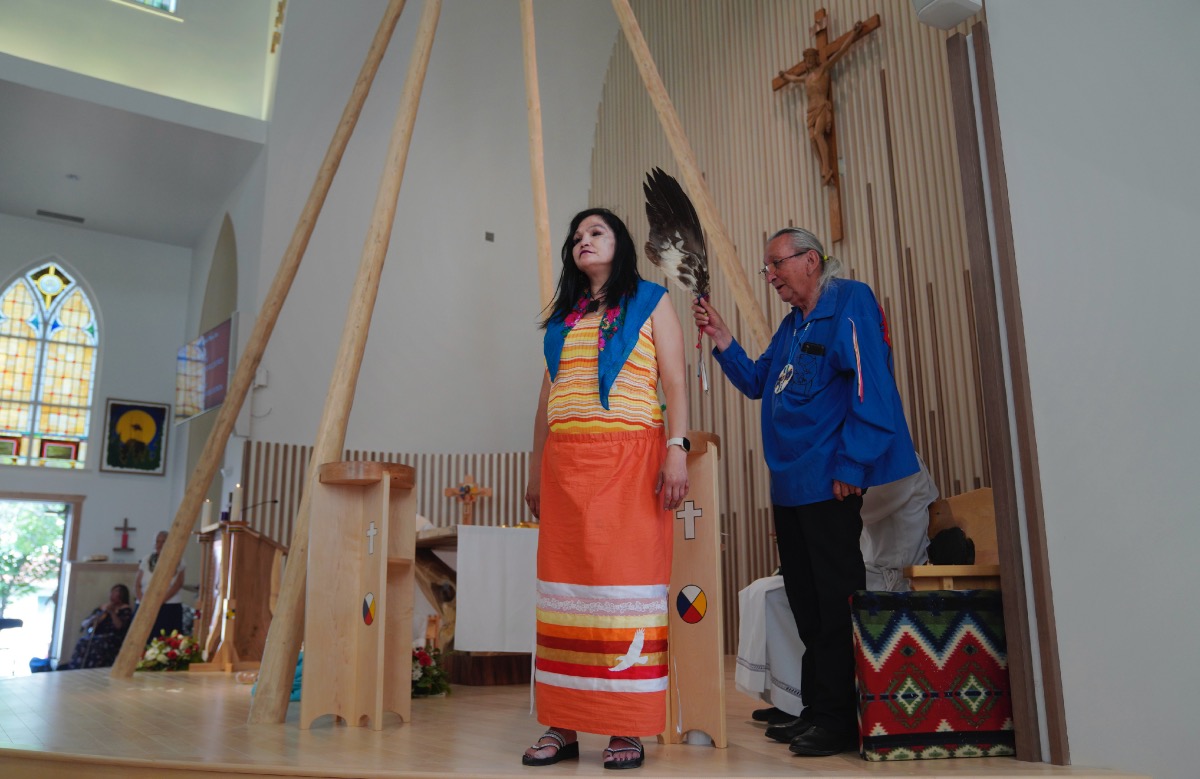
PETER SMITH, of Associated Press, on how, ahead of the papal trip this week, Indigenous Canadians are voicing a range of scepticism, wariness and hope…
Maskwacis, Alberta, Canada
AP
To this day, Flo Buffalo doesn’t drink milk – not since two nuns force-fed her the sour milk she had refused at the Catholic-run Ermineskin Indian Residential School for Indigenous children that she attended in the 1960s.
Holding out her right hand, she showed how she has never been able to fully straighten it out since a nun severely beat her with a stick.
“The nuns, they were real mean,” Buffalo said.

Flo Buffalo, a survivor of the Ermineskin residential school, stands for a portrait at the Montana First Nation band office on Tuesday, 19th July, in Maskwacis, Alberta. PICTURE: AP Photo/Jessie Wardarski.
With international attention focusing on the former school in the prairie town of Maskwacis as Pope Francis visits Monday to apologise for abuses in a system designed to sever Native children from their tribal, family and religious bonds, Indigenous Canadians such as Buffalo are voicing a range of scepticism, wariness and hope.
Buffalo, a member of the Samson Cree First Nation in central Alberta, doesn’t often talk about her two years at the school. But ahead of the pontiff’s visit, she sat down to relate her experiences to Associated Press journalists and a small group of teen girls who are learning about the traumatic legacy of the schools.
“It shouldn’t be him apologising. It should be them.”
Flo Buffalo, who attended the Catholic-run Ermineskin Indian Residential School for Indigenous children in the 1960s
Speaking in the council chambers of the Montana First Nation, a neighbouring Cree tribe where she now works, Buffalo recalled that the nuns, who were white, beat the girls when they spoke in their native Cree instead of English.
At the same time, Buffalo, 67, said she often defied the nuns.
“I scared the hell out of them, because I wouldn’t put up with their…” she said, completing the sentence with a mischievous chuckle.
Buffalo still considers herself Catholic. But she’s not going to attend Monday’s event with Francis – she doesn’t want to deal with the crowds, and the ones she holds responsible are the nuns who abused her and never offered an apology while they were alive.
“It shouldn’t be him apologising,” Buffalo said. “It should be them.”
When Mavis Moberly heard the Pope was coming, the news triggered some of the trauma she carries from her years at a residential school in northern Alberta. But after tears, prayers and a traditional smudging ceremony, a purification rite with scented plants, she found herself looking forward to hearing the pope’s apology.
“Maybe it’s going to help me to heal and to have a little bit more inner peace,” she said after last Sunday’s Mass at Sacred Heart Church of the First Peoples, a Catholic parish in Edmonton oriented to Indigenous people and culture.

Parishioners stand to receive communion during the rededication ceremony and Sunday Mass at Sacred Heart Church of the First Peoples on 17th July, in Edmonton, Alberta. In 2020, the church was damaged in a large fire and has now been renovated ahead of Pope Francis’ visit to the Canadian province. PICTURE: AP Photo/Jessie Wardarski.
The papal apology is years, if not generations, in the making.
From the 19th century into much of the 20th, Canada’s government collaborated with Catholic and Protestant churches to run residential schools in “an education system in name only”, designed to weaken tribal identities and Indigenous resistance to land grabs, according to a 2015 report by the Truth and Reconciliation Commission of Canada.
It identified 139 schools, the majority Catholic-run, where about 150,000 students were sent.
“Children were abused, physically and sexually,” the report said, adding that schools were unsanitary and unsafe facilities where thousands of children died of disease, fire and other causes.
For decades, various Catholic and Protestant church groups have offered apologies, and Pope Benedict XVI in 2009 expressed his “personal anguish”.
But the painful history took on new urgency last year when surveys of former schools with ground-penetrating radar found evidence of hundreds of unmarked graves.
Pope Francis met with a Canadian Indigenous delegation this spring and apologised “for the deplorable conduct of those members of the Catholic Church” involved with the schools. He also heeded survivors’ calls to make an apology on Canadian soil, leading to Monday’s event where thousands of attendees are expected.
Today, the Ermineskin residential school has largely been torn down. In its place stands a newer set of school buildings, run by four Cree nations in and around Maskwacis. A large tipi in front of the secondary school demonstrates how educators are promoting pride in the once-suppressed Indigenous culture.
Rose Pipestem, a member of the Montana First Nation who is also a survivor of the Ermineskin school, said she will try to see the pope. But like Buffalo, she believes the perpetrators should have apologised.
“I’m going to go see him,” she said, sitting in the council chambers near a line of photos of past Montana chiefs. “I’m not mad at him.”

Rose Pipestem, a survivor of the Ermineskin residential school, sits for an interview on Tuesday, 19th July, in Maskwacis, Alberta. Pipestem was placed in the residential school at three-years-old after her mother died. She doesn’t have conscious memories of abuse at the school, but she said a classmate told her years later that a nun had beaten her until she bled. PICTURE: AP Photo/Jessie Wardarski.
Pipestem doesn’t have conscious memories of abuse at the school, where she lived from age 3 after her mother died. But a classmate told her years later that a nun had beaten her until she bled because she wasn’t doing her work on the blackboard fast enough.
“It just shocked me,” she said through tears.
Pipestem did not file a claim for compensation because she can’t recall the incident. But she knows there was abuse at the school.
“I’m always grateful I’m still around,” she said. “I think it kind of made me stronger.” She reached a point where “I didn’t believe in the Catholic religion. Why did they allow all these things to happen?”
Other survivors have found spiritual solace in Catholicism.
We rely on our readers to fund Sight's work - become a financial supporter today!
For more information, head to our Subscriber's page.
On Sunday, worshippers crowded into Sacred Heart for the rededication of the sanctuary after a fire. The newly restored space features large wooden beams in the shape of a tipi over the altar and evocative images of Jesus and his followers portrayed with Indigenous features.
Drummers accompanied a procession into the church, followed by a multicultural mix of musical styles and a liturgy in English and Cree.
“This church has been a part of my healing journey,” said Moberly, who has been attending for many years.
She said that as a young adult, still traumatized by her school experiences, she rejected the Catholic faith for a time, turned to drinking and made poor choices. But when she became a grandmother, she resolved to change her ways and set a strong example for others.
“It wasn’t an easy task,” she said. “There was many tears.”

Church elder Fernie Marty gives ceremonial blessing to parishioners at Sacred Heart Church of the First Peoples on Sunday, 17th July, in Edmonton, Alberta. Marty is a survivor of a day school for Indigenous children, which had culturally repressive policies similar to that of residential schools. He has continued practicing his Catholic faith in conjunction with Indigenous ceremonies. PICTURE: AP Photo/Jessie Wardarski.
Church elder Fernie Marty, 73, said Francis’ visit will not only bring reconciliation but encourage what he calls “reconcili-action”.
“We all play a part in making sure that those kinds of atrocities never happen again on Canadian soil,” Marty said.
Edmonton Archbishop Richard Smith said the Pope’s visit sends a message not only with words but with action, since he’s coming to Canada even as he has canceled other trips due to health problems.
“This is showing…how important it is for him to demonstrate personally his personal closeness to the Indigenous peoples,” Smith said.






